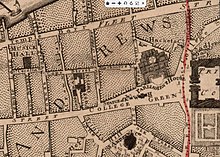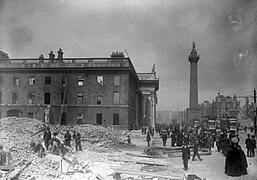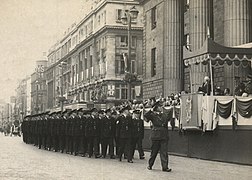General Post Office, Dublin
| General Post Office | |
|---|---|
Ard-Oifig an Phoist | |
 The General Post Office in 2006 | |
| Alternative names | GPO |
| General information | |
| Type | Post office and administrative offices |
| Architectural style | Greek Revival, neoclassical |
| Location | O'Connell Street Lower Dublin 1 D01 F5P2 |
| Coordinates | 53°20′58″N 6°15′40″W / 53.349334°N 6.261075°W |
| Construction started | 12 August 1814 |
| Inaugurated | 6 January 1818 |
| Cost | 50,000 pounds sterling |
| Owner | Office of public works |
| Design and construction | |
| Architect(s) | Francis Johnston |
The General Post Office (GPO; Irish: Ard-Oifig an Phoist) is the former headquarters of An Post — the Irish Post Office. It remains its registered office and the principal post office of Dublin[1] — the capital city of Ireland — and is situated in the centre of O'Connell Street, the city's main thoroughfare. It is one of Ireland's most famous buildings, not least because it served as the headquarters of the leaders of the Easter Rising. It was the last great Georgian public building to be erected in the capital.
Architecture
[edit]
The foundation stone of the building, which was designed by Francis Johnston, was laid by the Lord Lieutenant of Ireland, Charles Whitworth, 1st Earl Whitworth, on 12 August 1814, attended by the Post-Masters-General, Charles O'Neill, 1st Earl O'Neill and Laurence Parsons, 2nd Earl of Rosse.[2][3] The structure was completed in the short space of approximately three years at a cost (depending on sources) of between £50,000[4] and £80,000.[5]
The front elevation is 67.1 metres (220 ft) long. It features a portico (24.4 metres (80 ft) wide) of six fluted Ionic columns, 137.16 centimetres (54 inches) in diameter. The frieze of the entablature is highly enriched. The tympanum of the pediment originally carried the royal arms; following restoration in the 1920s, they were removed. On the acroteria of the pediment are three statues by John Smyth:[6] when facing the building Mercury on the left, with his Caduceus and purse; Fidelity on the right, with a hound at her feet and a key held in her right hand (due to these features it is argued[by whom?] that the statue is in fact of Hecate); and Hibernia in the centre, resting on her spear and holding a harp. The entablature, with the exception of the architrave, is continued along the rest of the front; the frieze, however, is not decorated over the portico. A balustrade surmounts the cornice of the building, which is 15.2 metres (50 ft) from the ground.
With the exception of the portico, which is of Portland stone, the main building is of mountain granite. The elevation has three stories, of which the lower or basement is rusticated. The portico occupies the entire height of the structure.
The GPO Arcade is an art deco style shopping arcade at the rear of the complex, with access from Henry Street and Princes Street North.[7][8] It was built by the Office of Public Works following the Rising.[9] Local radio station, Millennium 88FM was based here.[8]
History
[edit]
The General Post Office in Ireland was first located in High Street in Dublin moving to Fishamble Street in 1689, to Sycamore Alley in 1709 and then in 1755 to Peter Bardin's Chocolate House at Fownes Court on the site where the Commercial Buildings used to be (later the Central Bank building).[10][5] It was afterwards removed to a larger house opposite the Bank of Ireland building on College Green. On 6 January 1818, the new post office in Sackville Street (now O'Connell Street) was opened for business.[11]
During the Easter Rising of 1916, the GPO served as the headquarters of the uprising's leaders. It was from outside this building on 24 April 1916, that Patrick Pearse read out the Proclamation of the Irish Republic.[12] The building was destroyed by fire in the course of the rebellion, save for the granite facade, and not rebuilt until 1929, by the Irish Free State government. An original copy of the Proclamation of the Irish Republic was displayed in the museum at the GPO.
The museum was closed at the end of May 2015 and replaced by a new visitor centre to commemorate the 1916 Rising, "GPO Witness History", in March 2016.[13] The building has remained a symbol of Irish nationalism. In 1935, in commemoration of the Rising, a statue depicting the death of the mythical hero Cúchulainn sculpted by Oliver Sheppard in 1911 was installed at the command post in the centre of the GPO main hall and is now housed in the front of the building. The statue was featured on the Irish ten shilling coin of 1966, marking the fiftieth anniversary of the Rising. Despite its significance in the history of Irish independence, ground rent for the GPO continued to be paid to English and American landlords until the 1980s.[14]
The broadcasting studios of 2RN, which later became Radio Éireann, were located at the GPO from 1928 until 1974.[15] Draws for Prize Bonds are held weekly, on Fridays, in the building.
Nelson's Pillar was located in the centre of O'Connell Street adjacent to the GPO, until it was destroyed by Irish republicans in an explosion in 1966. The Spire of Dublin was erected on the site of the Pillar in 2003.
The Hibernia statue was depicted on the obverse of a commemorative 2 euro coin marking the Centenary of the Easter Rising in 2016.[16]
The postal service An Post moved its headquarters from the General Post Office building to new premises at North Wall Quay in Dublin, in June 2023.[1]
Images
[edit]-
The General Post Office c. 1830
-
The GPO in an engraving from about 1831
-
Before independence with a British flag flying. The adjacent Hotel Metropole was destroyed in 1916 during the Easter Rising.
-
The shell of the GPO after the Rising; Nelson's Pillar can be seen on the right.
-
A plaque commemorating the Easter Rising at the GPO
-
1964 view from Nelson's Pillar
-
A sign on the external wall of the General Post Office, with the building's name (Irish: Árd Oifig an Phuist) in traditional Gaelic script and using an older spelling that predates Irish orthography reforms of the 1960s
-
The General Post Office in 2006
References
[edit]- ^ a b An Post moves headquarters from GPO to new premises RTÉ News, 2023-06-22.
- ^ Haydn, Joseph (1851). The Book of Dignities. London: Longmans, Brown, Green and Longmans. p. 461.
- ^ M'Gregor, John James (1821). Picture of Dublin:comprehending a history of the city; an accurate account of its various establishments and institutions and a correct description of all edifices connected with them. Dublin: A. M Graham. p. 40.
- ^ "History & Heritage – Dublin's General Post Office". An Post. Retrieved 23 November 2017.
The whole building was built in less than 4 years at a cost of about £50,000
- ^ a b Ferguson, Stephen (2014). The GPO - 200 Years of History. Dublin: Mercier Press. pp. 14–41. ISBN 9781781172773.
- ^ "Irish Architecture Online: 1814 – General Post Office, O'Connell Street, Dublin". Archiseek.com. 2017. Retrieved 28 November 2017.
- ^ Fagan, Jack (24 October 2018). "Leasehold on Dublin's GPO Arcade and 10 shops for sale". The Irish Times. Retrieved 14 May 2019.
- ^ a b "'I made a few thousand selling Eircom shares'". Independent.ie. 6 January 2019. Retrieved 14 May 2019.
- ^ "Dublin's GPO Marks 200 years in business". Newstalk.com. 11 January 2018. Retrieved 14 May 2019.
- ^ "Dublin Post Office". The Mirror of Literature, Amusement and Instruction. X (272). London: J. Limbird. 1827 – via Project Gutenberg.
- ^ McCarty, Denise (23 January 2018). "Bicentenary commemorative stamp honors Ireland's General Post Office". World Stamps. Linns Stamp News. Retrieved 25 March 2018.
- ^ "Easter Rising – Day 1: Rebels on the streets". The Irish Times. Retrieved 25 June 2018.
- ^ Murphy, Darragh (13 January 2016). "The GPO then and now". The Irish Times. Retrieved 6 April 2018.
- ^ "Ceisteanna – Questions: Oral Answers – GPO Ground Rent". Dáil Éireann Debate Vol. 328 No. 15. Oireachtas. 19 May 1981. Retrieved 27 June 2021.
- ^ "History of Raidió Teilifís Éireann". Raidió Teilifís Éireann. Retrieved 8 August 2020.
- ^ Flaherty, Rachel (20 January 2016). "Commemorative €2 coin released to mark 1916 centenary". The Irish Times. Retrieved 20 July 2022.
External links
[edit]- An Post History and Heritage – The GPO Museum
- The 1916 Rising by Norman Teeling at the Wayback Machine (archived 30 July 2020)[dead link]—A ten-painting suite of events of the Easter Rising acquired for permanent display at the GPO
- Buildings and structures in Dublin (city)
- Easter Rising
- Government buildings completed in 1818
- Headquarters in Ireland
- History of Ireland (1801–1923)
- Post office buildings
- Republic of Ireland postal system
- 20th-century architecture in the Republic of Ireland
- 19th-century architecture in the Republic of Ireland
- Georgian architecture in Dublin (city)










